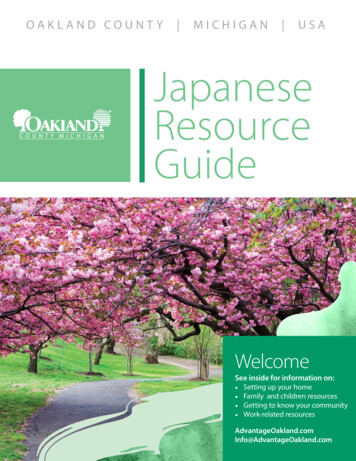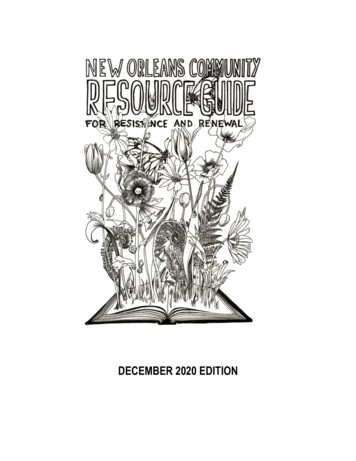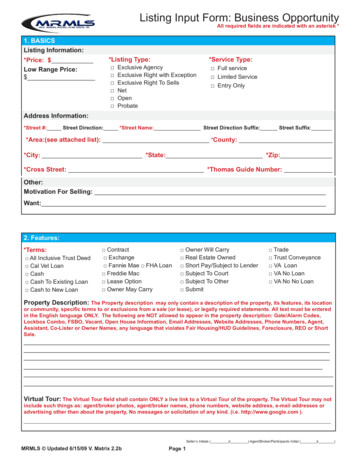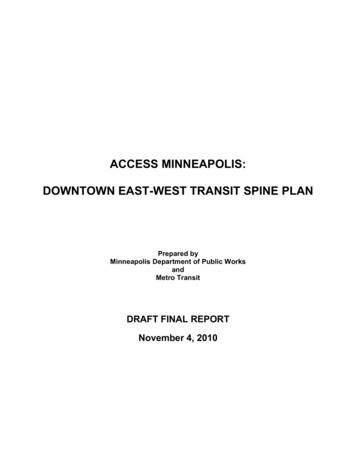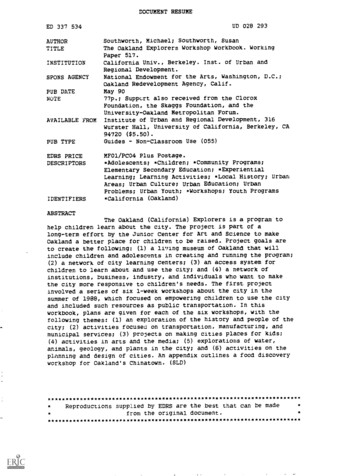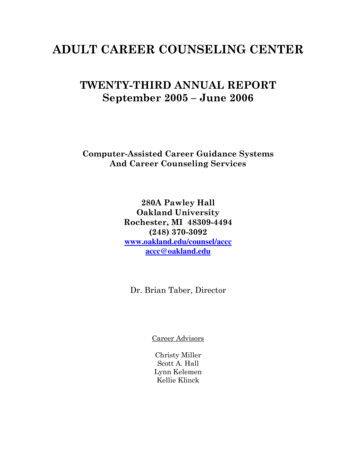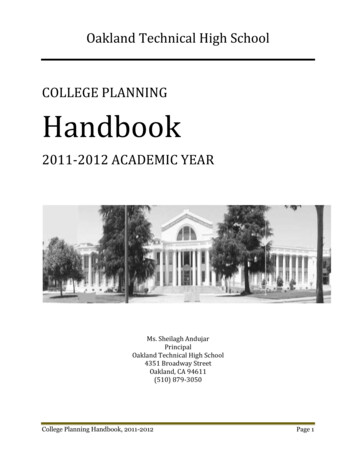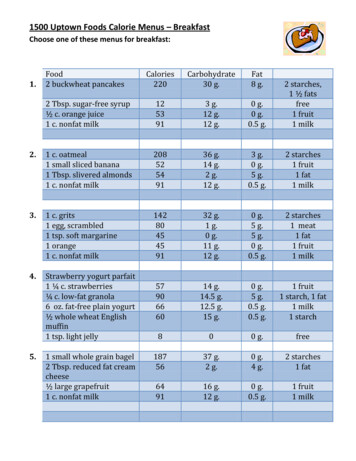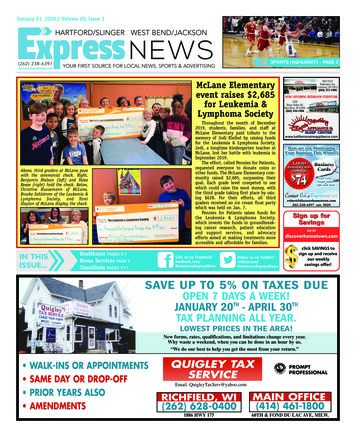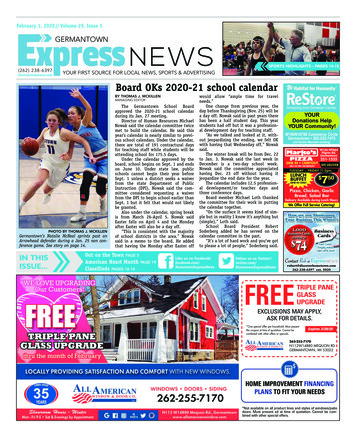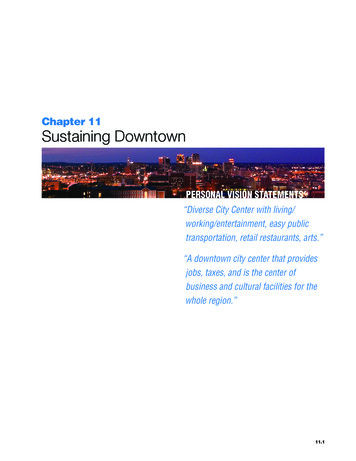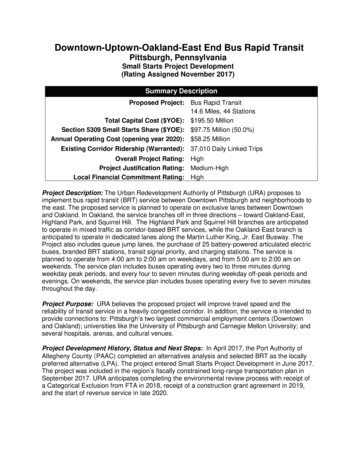
Transcription
Downtown-Uptown-Oakland-East End Bus Rapid TransitPittsburgh, PennsylvaniaSmall Starts Project Development(Rating Assigned November 2017)Summary DescriptionProposed Project: Bus Rapid Transit14.6 Miles, 44 StationsTotal Capital Cost ( YOE): 195.50 MillionSection 5309 Small Starts Share ( YOE): 97.75 Million (50.0%)Annual Operating Cost (opening year 2020): 58.25 MillionExisting Corridor Ridership (Warranted): 37,010 Daily Linked TripsOverall Project Rating: HighProject Justification Rating: Medium-HighLocal Financial Commitment Rating: HighProject Description: The Urban Redevelopment Authority of Pittsburgh (URA) proposes toimplement bus rapid transit (BRT) service between Downtown Pittsburgh and neighborhoods tothe east. The proposed service is planned to operate on exclusive lanes between Downtownand Oakland. In Oakland, the service branches off in three directions – toward Oakland-East,Highland Park, and Squirrel Hill. The Highland Park and Squirrel Hill branches are anticipatedto operate in mixed traffic as corridor-based BRT services, while the Oakland-East branch isanticipated to operate in dedicated lanes along the Martin Luther King, Jr. East Busway. TheProject also includes queue jump lanes, the purchase of 25 battery-powered articulated electricbuses, branded BRT stations, transit signal priority, and charging stations. The service isplanned to operate from 4:00 am to 2:00 am on weekdays, and from 5:00 am to 2:00 am onweekends. The service plan includes buses operating every two to three minutes duringweekday peak periods, and every four to seven minutes during weekday off-peak periods andevenings. On weekends, the service plan includes buses operating every five to seven minutesthroughout the day.Project Purpose: URA believes the proposed project will improve travel speed and thereliability of transit service in a heavily congested corridor. In addition, the service is intended toprovide connections to: Pittsburgh’s two largest commercial employment centers (Downtownand Oakland); universities like the University of Pittsburgh and Carnegie Mellon University; andseveral hospitals, arenas, and cultural venues.Project Development History, Status and Next Steps: In April 2017, the Port Authority ofAllegheny County (PAAC) completed an alternatives analysis and selected BRT as the locallypreferred alternative (LPA). The project entered Small Starts Project Development in June 2017.The project was included in the region’s fiscally constrained long-range transportation plan inSeptember 2017. URA anticipates completing the environmental review process with receipt ofa Categorical Exclusion from FTA in 2018, receipt of a construction grant agreement in 2019,and the start of revenue service in late 2020.
Locally Proposed Financial PlanSource of FundsFederal:Section 5309 Small StartsTotal Funds ( million)Percent of Total 97.7550.0%Section 5307 Urbanized Area FormulaFunds 13.104.1%Section 503 Advanced Transportationand Congestion ManagementTechnologies Deployment (ATCMTD)Program 10.855.6%Section 5339 Buses and Bus FacilitiesInfrastructure Investment Program 2.904.1%FHWA Flexible Funds (CongestionMitigation and Air Quality Program) 1.570.8% 22.5111.5%State Bonds 3.401.7%State General Funds 2.791.4%Department of Transportation MultimodalTransportation Fund (Bonds) 2.251.2%State Sales Tax 1.550.8% 18.429.4% 12.766.5%Uptown Eco-Innovation District TransitRevitalization Investment DistrictBonds 5.002.6%Allegheny County Bonds 0.600.3%Allegheny County Sales Tax 0.050.0% 195.50100.0%State:State Capital Budget TransportationAssistance Program Authorization(Sales Tax)Local:Allegheny County General FundsCity of Pittsburgh, In-Kind StationContributionTotal:
NOTE: The financial plan reflected in this table has been developed by the project sponsor and does not reflect a commitmentby DOT or FTA. The sum of the figures may differ from the total as listed due to rounding.
Downtown-Uptown-Oakland-East End BRTPittsburgh, PennsylvaniaSmall Starts Project Development(Rating Assigned November 2017)LAND USE RATING: Medium-HighThe land use rating reflects population density within one-half mile of proposed stations, employment servedby the line, and the share of legally binding affordability restricted (LBAR) housing in the station areascompared to the share in the surrounding county. An estimated 259,000 jobs would be served by the project, which corresponds to a High ratingaccording to FTA benchmarks. Average population density across all station areas is 9,000 personsper square mile, corresponding to a Medium rating. In the central business district (CBD), dailyparking fees average 20, which rates as High. The proportion of LBAR housing in the projectcorridor compared to the proportion throughout all of Allegheny County is 1.64, which rates Medium. Station areas in the CBD and Oakland are typically high-density commercial andcommercial/institutional in character, and together, these two neighborhoods contain the majority ofPittsburgh’s jobs. Station areas outside of these two neighborhoods contain single-family, multifamily and mixed-use developments. Existing development along the entire line is predominantly urban in character, with dense, walkablestreet grids sectioned out based on the city’s sloping elevation. Sidewalks are present throughout justabout every street, including smaller, residential side streets.ECONOMIC DEVELOPMENT RATING: MediumTransit-Supportive Plans and Policies: Medium Transit-Supportive Corridor Policies: The City of Pittsburgh does not have an adoptedcomprehensive plan. However, transit-supportive neighborhood or small area plans have beendeveloped for some portions of the corridor, especially those most likely to see new development,such as the Oakland and Uptown neighborhoods.Supportive Zoning Regulations Near Transit Stations: Pittsburgh zoning provides densities that aresupportive of transit oriented development. Within the CBD and mixed-use and commercial areashigh density development is permitted, while within residential districts medium-low to high densitydevelopment is permitted. There are code provisions allowing pedestrian friendly, shallow setbacks.Parking requirements are generally transit supportive.Tools to Implement Land Use Policies: Pittsburgh’s primary financial tool to leverage development isthe Transit Revitalization Investment District (TRID) Program. The TRID Program captures increasesin real property taxes resulting from new development in order to pay for necessary publicinfrastructure, including transportation improvement, as well as certain eligible developments. Thereis one active and one proposed TRID in the corridor. Community outreach, including discussion ofdevelopment that is transit supportive, has been undertaken as part of neighborhood planning effortsin various parts of the corridor.Performance and Impacts of Policies: Medium Performance of Land Use Policies: Approximately 7,000 market rate rental units and more than2,500 low-income units are slated for construction in upcoming years, most of which will beconstructed within a half mile of the proposed BRT stations. While most development is occurringdowntown and in Oakland, examples were provided of high-density, transit-supportive projects inOakland and Squirrel Hill as well.Potential Impact of Transit Investment on Regional Land Use: A significant amount of vacant andunderutilized land exists in the corridor, mainly within Uptown and the western fringes of Oakland.These parcels typically have TOD-supportive zoning, but most are small, and land assembly is notedas a potential challenge. Many of the industries in the CBD and Oakland hubs, which togethercontain over 200,000 jobs, have seen increases in employment in recent years.
Tools to Maintain or Increase Share of Affordable Housing: Medium-Low Pittsburgh’s planning and tools for affordable housing appear limited but are receiving increasingattention. The Pittsburgh Affordable Housing Task Force was established in 2015 and hasrecommended establishing a trust fund with the goal of providing a substantial pool of resources totarget housing needs in the city, including funding for families earning at or below 30 percent of thearea median income. Other strategies are proposed in local planning and policy documents.
Downtown-Uptown-Oakland-East End Bus Rapid Transit – Pittsburgh, Pennsylvania!POutbound Station ( ioSt (WellesleyFifth/Atwood StationOhEast LibertyEPenn§ Negley BuswayStation§ 579etrieBridgmghaBirminonJumMlouForbesAvePenincol n§ ReivnIrviteS!P The following Buswaytransit stations arelocated to the east ofthe map extent:1. Homewood2. WilkinsburgNorthumberlandWightman ( (Murray ( Forward30 rBoggs LRT!P !P2Ave ( Margaret Morrison (vedAa!P 0.5n ( Phillips2nelah0Miles1Pen ( Beacon376ngSouth HillsJunction LRTMorewood (CMU)wyoonE Carson StPkWalnut (Blvd of the AlliesnL!PEllsworth ( Negley ( AikenStlvi ( ( Collegeeson( Semple ( (( Craft (( (Craig (Schenley (Oakland (HalketCraft ( ( (East LibertyBusway Station ( (Morewood ( (BatePridhamhatCmJu ( ( ((le fthFiAtwoodMStationSquare LRTiltergMrgvilleePlachamhatCieldossRithfSm M!Pbeen ( (r !P ( (iltbeen FirstAvenue LRTeidPr !P (eSt ( ! P( ( ( (ereAvCir SN!PlvdmBCraigTennysonnPen ( PelzalaSteelPlaza LRT dooWBau 22 Centre GatewayCenter LRTeloBiglvdwBStLiberty/Market !P (rveraigOhioRiverWoodStreet LRTgnyheRiNCleAlAllegheny LRTNorth Side LRT!PCirPenn Ave279!PStanton(Under construction as a separate project)dEuclid (Light Rail / BuswayTransit StationWashington BlvSquirrel Hill BRTny ( (AvepyExInbound StationValleyHighland Park BRTBunker HillLight RailTwo-Way Station (heMarshall AveExisting Transit Service5th§ Oakland-EastBusway BRTHovAll eg19 Proposed Routing (MorrowfieldWelfer ( Loretta !P
Pittsburgh's primary financial tool to leverage development is the Transit Revitalization Investment District (TRID) Program. The TRID Program captures increases in real property taxes resulting from new development in order to pay for necessary public infrastructure, including transportation improvement, as well as certain eligible developments.
